Knowing how to make chicken bone broth is a skill every home cook should have. This simple stovetop method only requires a few ingredients, along with a bit of time and patience. Perfect for making ahead and freezing, this versatile pantry staple can be used in a wide variety of recipes.
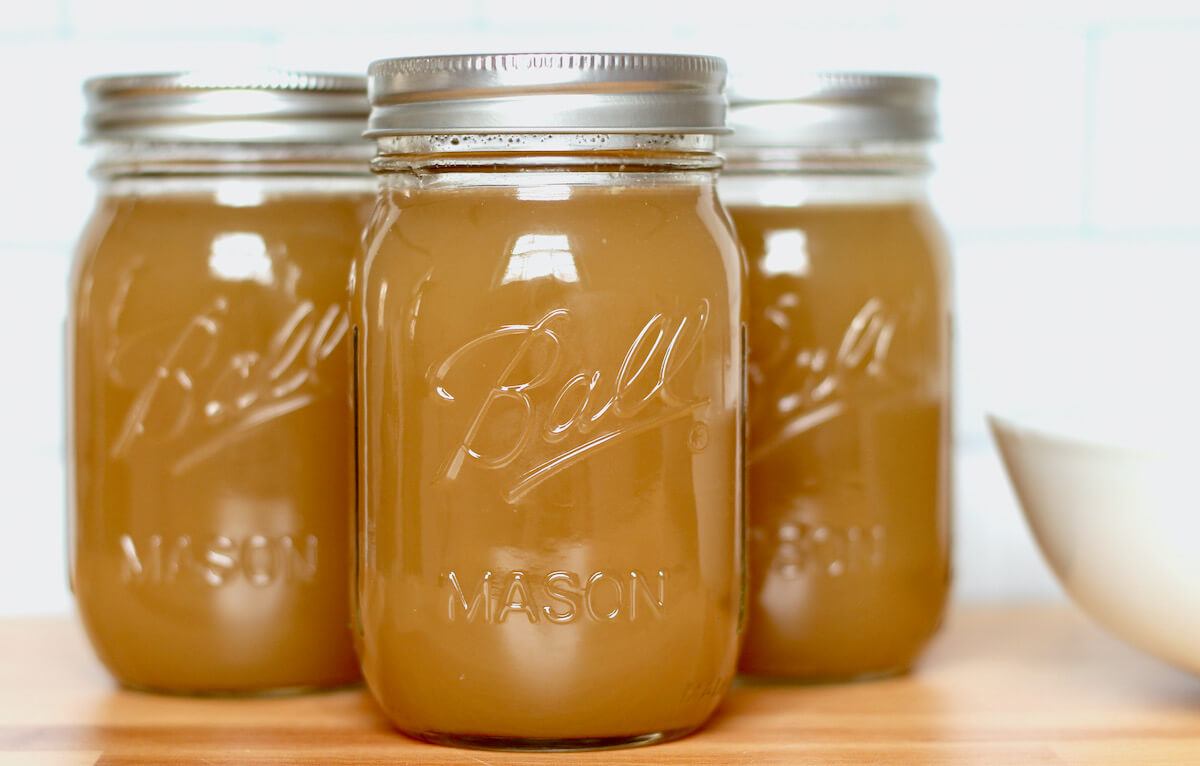
If you're looking for a way to take your favorite dishes to the next level, look no further than homemade chicken bone broth.
Homemade chicken bone broth is packed with rich and savory flavors you won't find in store-bought chicken stock. Plus, it's an easy and cost-effective way to reduce food waste and make the most of your chicken bones and scraps.
Making chicken bone broth on the stovetop is a simple process that requires just a few ingredients and a bit of patience. And the results are well worth the effort. You'll be left with a delicious homemade broth that is perfect for making soups, stews, sauces, and much more.
So, if you're ready to learn how to make the best chicken bone broth from scratch, keep reading for all of my best tips and tricks.
Disclaimer: Some links throughout this post are affiliate links. As an Amazon Associate, I earn from qualifying purchases. You can learn more by visiting my Affiliate Disclosure Page.
What is Chicken Bone Broth?
Chicken bone broth is chicken broth made by simmering chicken bones in water for at least 12 hours. Many recipes, including this one, also contain ingredients like vegetables, herbs, and salt.
Chicken Bone Broth Benefits
Because chicken bone broth is simmered for a long period of time, we're able to extract lots of vitamins, minerals, and collagen from the chicken bones.
And while the amount of each nutrient in bone broth will vary depending on the ingredients used, in general, bone broth is rich in calcium, magnesium, potassium, phosphorous, vitamin K, vitamin A, and a variety of amino acids.
The high nutritional value of bone broth is thought to be beneficial for our gut as well as our joints, immune function, and sleep.
What is the Difference Between Bone Broth and Stock?
Chicken bone broth and chicken stock are very similar. Both are made from chicken bones simmered in water. And both may contain other ingredients like aromatics, herbs, and spices.
The difference comes down to how long each one is cooked. Chicken stock can be made in about 4-6 hours. On the other hand, chicken bone broth is usually simmered for at least 12-24 hours. The extended cooking time of chicken bone broth allows us to extract more nutrients from the bones.
Why Quality Ingredients Are Important
Quality matters when it comes to the ingredients we use in our chicken bone broth.
Ingredients can only provide what they have to offer in the first place. Many factors affect the nutrients in the food we eat - from the chicken's diet to the soil each vegetable is grown in. Choosing the highest quality ingredients possible will yield a higher quality chicken bone broth.
If possible, I recommend growing your own vegetables or visiting a local farmers' market. Additionally, sourcing pasture-raised chicken locally can provide you with higher-quality chicken bones.
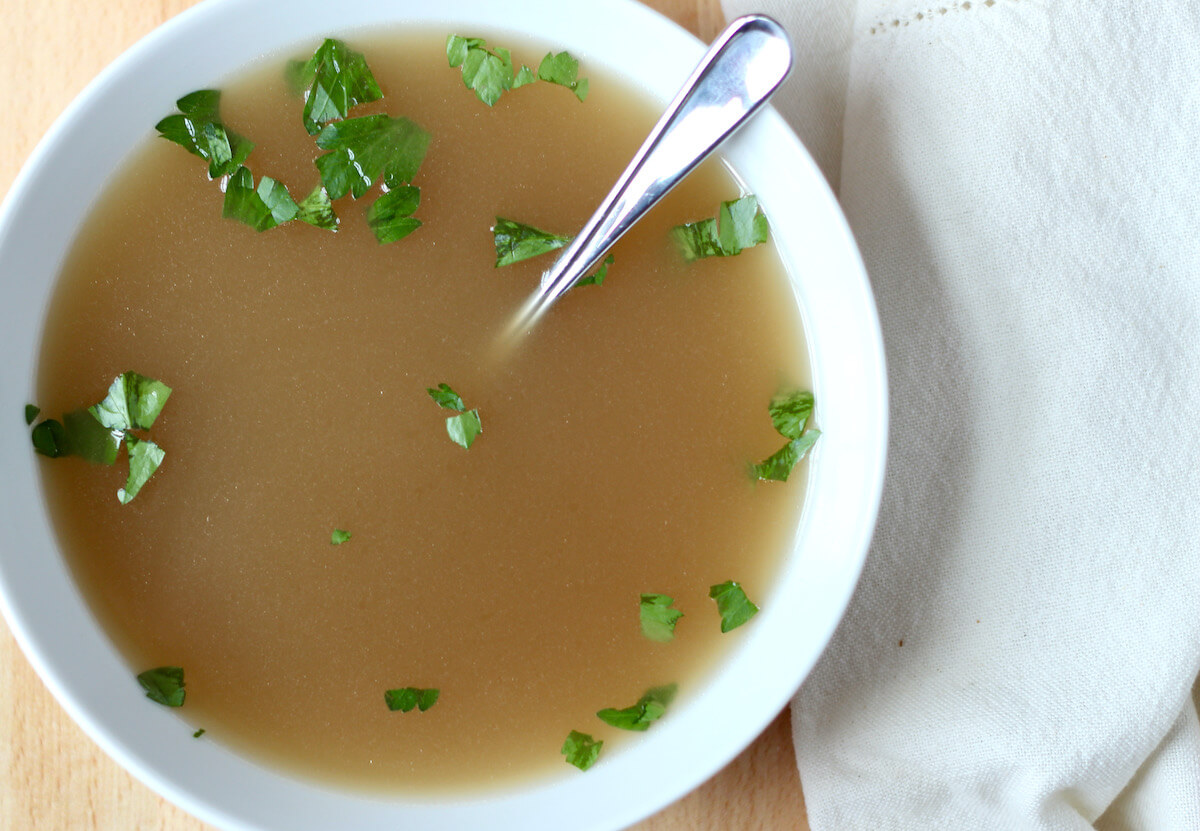
Why You'll Love This Recipe
- Versatile- Chicken stock is the base of so many easy recipes. From chicken noodle soup to risotto, homemade chicken stock will never go to waste.
- Flexible- Don't have time to make chicken stock the same day you made roasted chicken? Don't fret! Simply freeze the bones in a freezer-safe bag until you're ready to use them.
- Easy to Make- Chicken stock is a "set it and forget it" type of recipe. While you do need to plan to be home all day as it simmers on the stove, it's mostly hands-off.
- Healthy- Making chicken stock at home is great because you control the ingredients. Plus, the long and slow cook time means you're extracting all kinds of amazing nutrients out of the chicken bones. Something store-bought chicken stock often lacks.
Ingredient Notes
Here are some notes on the key ingredients. For the full list of ingredients, check out the recipe card below.
- Chicken Bones- Use any leftover chicken bones you have. Rotisserie chicken bones, whole roasted chicken bones, chicken wings, split chicken breasts, and chicken feet are all great options. If using raw bones, I recommend roasting for better flavor.
- Water- Use filtered water for the best flavor.
- Apple Cider Vinegar- Adding a small amount of acid helps extract nutrients from the chicken bones. Apple cider vinegar does not add a noticeable flavor to the stock.
- Aromatics- I typically use onion, garlic, carrots, and celery to flavor my chicken stock.
- Herbs- For this recipe, I only added a bay leaf. However, rosemary, thyme, and sage taste delicious in chicken stock as well.
- Kosher Salt- A small amount of kosher salt or sea salt enhances the flavor of the broth.
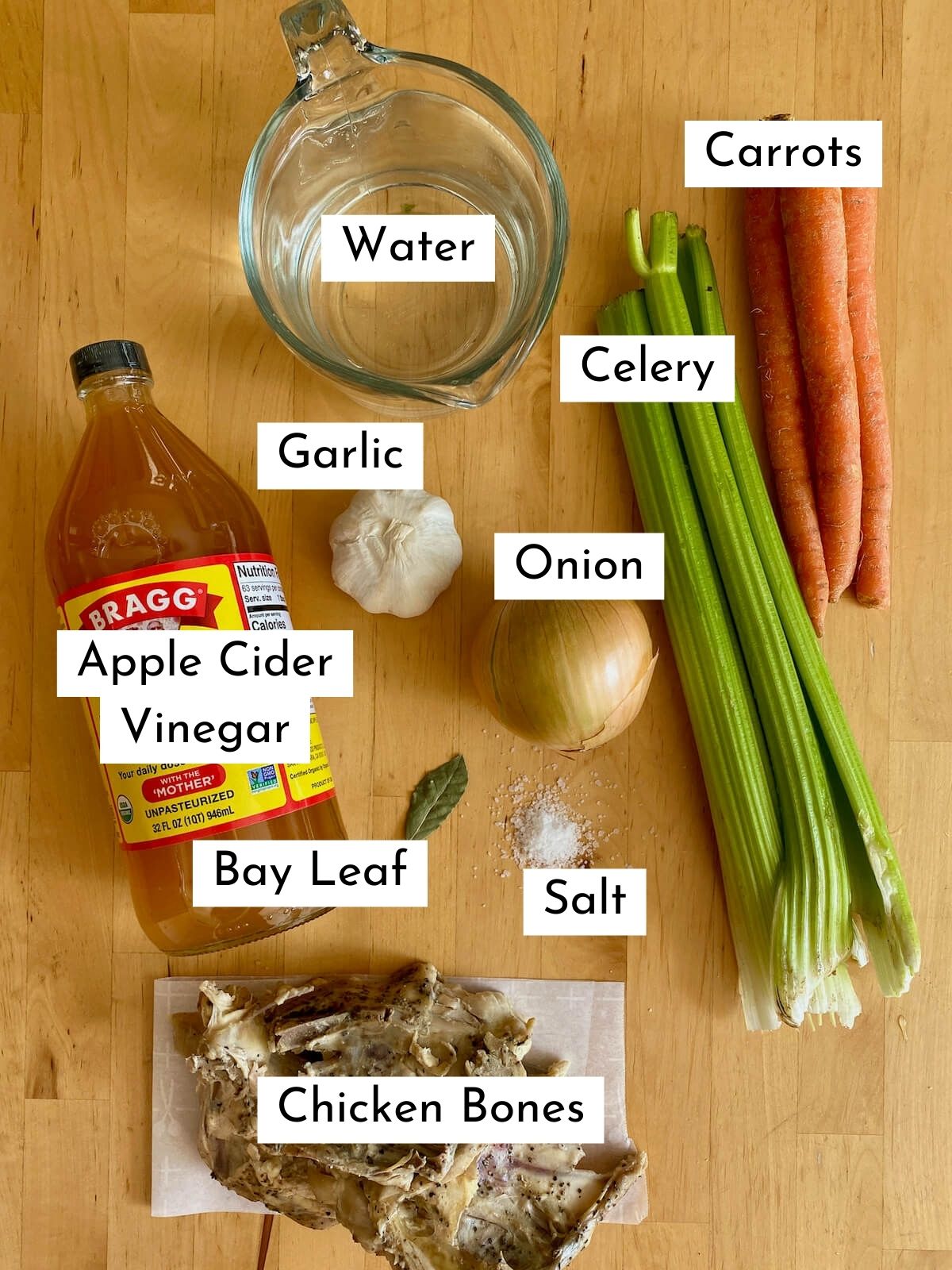
Where Do I Get Bones for Chicken Bone Broth?
Whenever you make a recipe that calls for bone-in chicken, such as this Lemon Garlic Roasted Chicken or this Dutch Oven Chicken Breast recipe, save the bones! You can either make chicken stock right away or save the bones in the freezer to make it later.
Other options include store-bought rotisserie chicken bones, buying bones from a local butcher, or asking friends and family to save leftover chicken bones for you.
Always remove as much of the chicken meat as you can from the bones before using them to make chicken stock. Then, use the meat to make chicken soup, chicken lasagna, or chicken pot pie.
🍗 Quick Tip: If using raw bones, roasted them on a rimmed baking sheet in a 400˚F oven for 20 minutes before adding them to your stockpot. This will enhance the overall flavor of the chicken stock.
Substitutions and Variations
Here are a few ways you can try customizing this chicken stock recipe to fit your diet and taste preferences.
Substitutions
- Chicken Bones- This recipe can be used to make turkey bone broth or beef bone broth. You can also use any combination of bones you prefer.
- Apple Cider Vinegar- Substitute apple cider vinegar for white vinegar or lemon juice.
- Aromatics- Use any aromatic vegetables you like or leave them out entirely. I love using onion, carrots, celery, garlic, leeks, cabbage, mushrooms, and broccoli or cauliflower stems.
- Herbs- Try using bay leaves, thyme, rosemary, sage, parsley, or marjoram.
- Kosher Salt- Swap for sea salt, Himalayan salt, or table salt.

Variations
- Herbed- Add a variety of herbs such as thyme, rosemary, and sage.
- Lemon- Throw in a few halved lemons for a citrusy flavor.
- Mushroom- For a deeper umami flavor, add some dried cremini or shiitake mushrooms.
Equipment Notes
Here are some notes on any special equipment I used to make this recipe.
- Large Stockpot- While not special or fancy, are large stockpot is key for making your own bone broth. I recommend using at least a 10-quart stockpot.
- Fine Mesh Sieve or Cheesecloth- Once the broth has finished cooking, you'll need something to strain it. A fine mesh sieve, cheesecloth, or even a clean lint-free kitchen towel can be used.
How to Make Chicken Bone Broth
Here is how to make chicken bone broth on the stove.
Step 1: Add all ingredients to the pot. Add the chicken bones, vegetables, bay leaf, vinegar, and kosher salt to a large stock pot. Pour in the water, making sure that everything is well-covered.

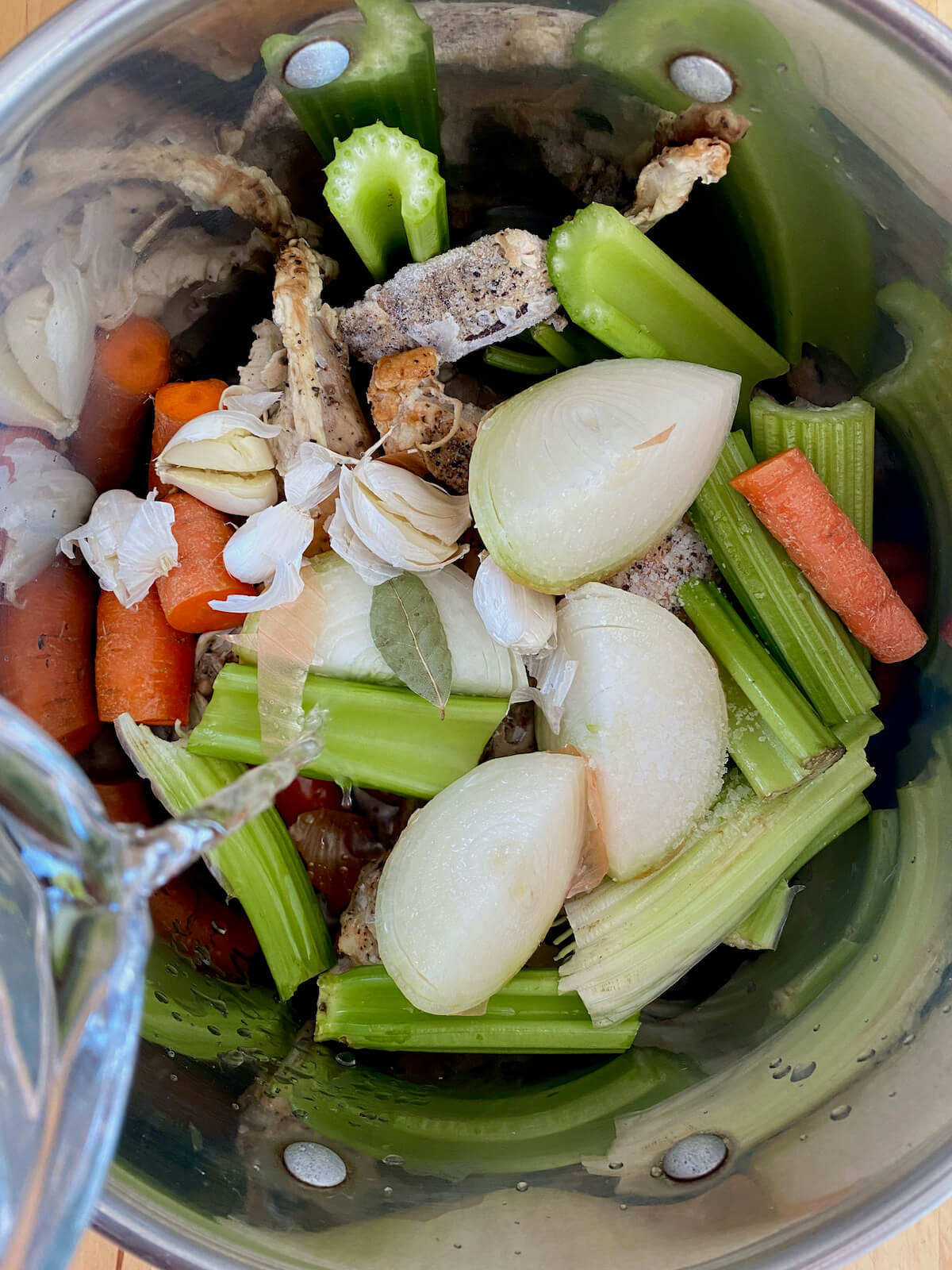
Step 2: Simmer the stock. Bring the water to a boil over medium-high heat, then reduce the heat to low so that the stock simmers gently. Skim off any foam that rises to the top as necessary. Cover and allow the stock to gently simmer for 12-14 hours.
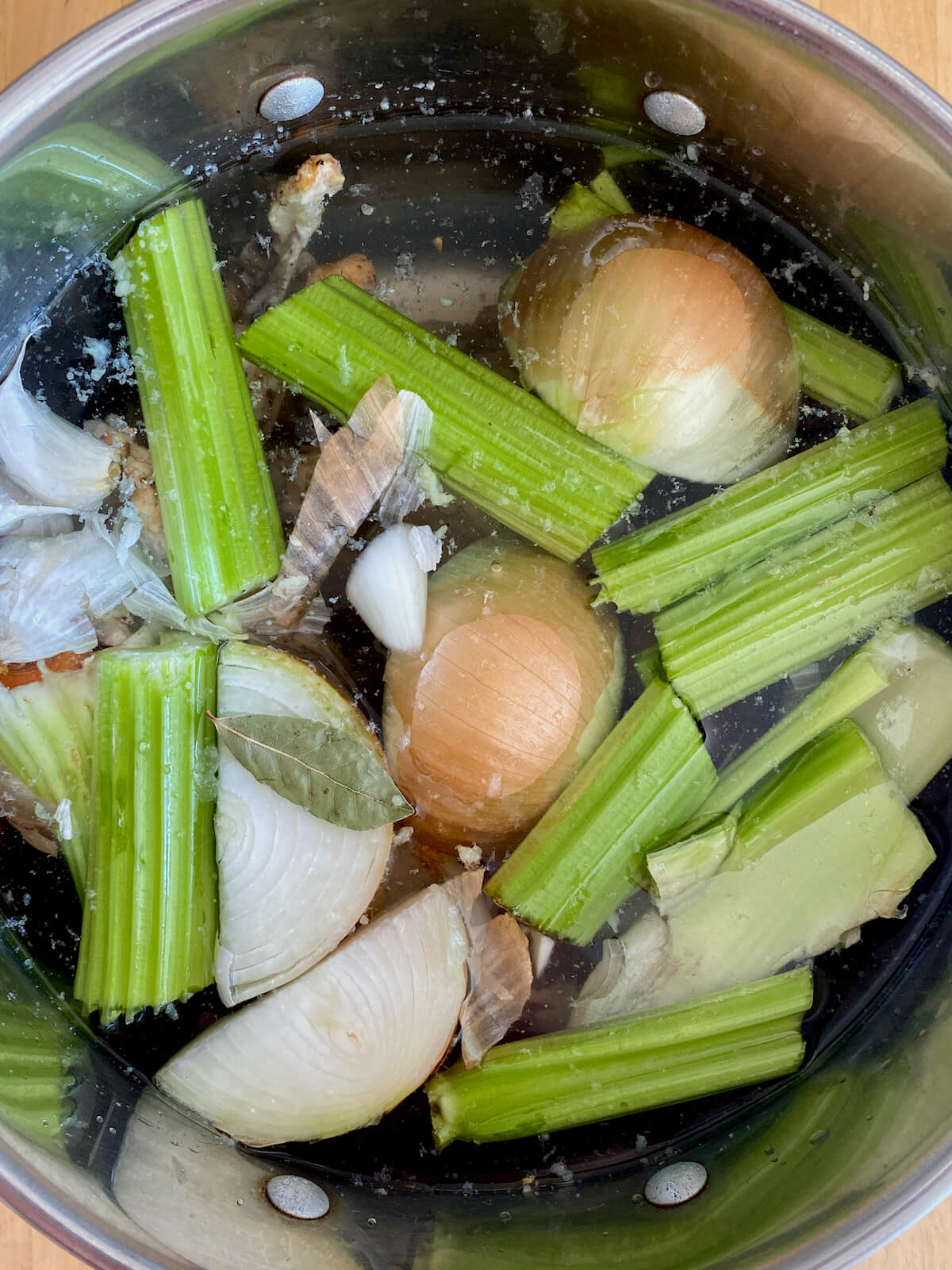
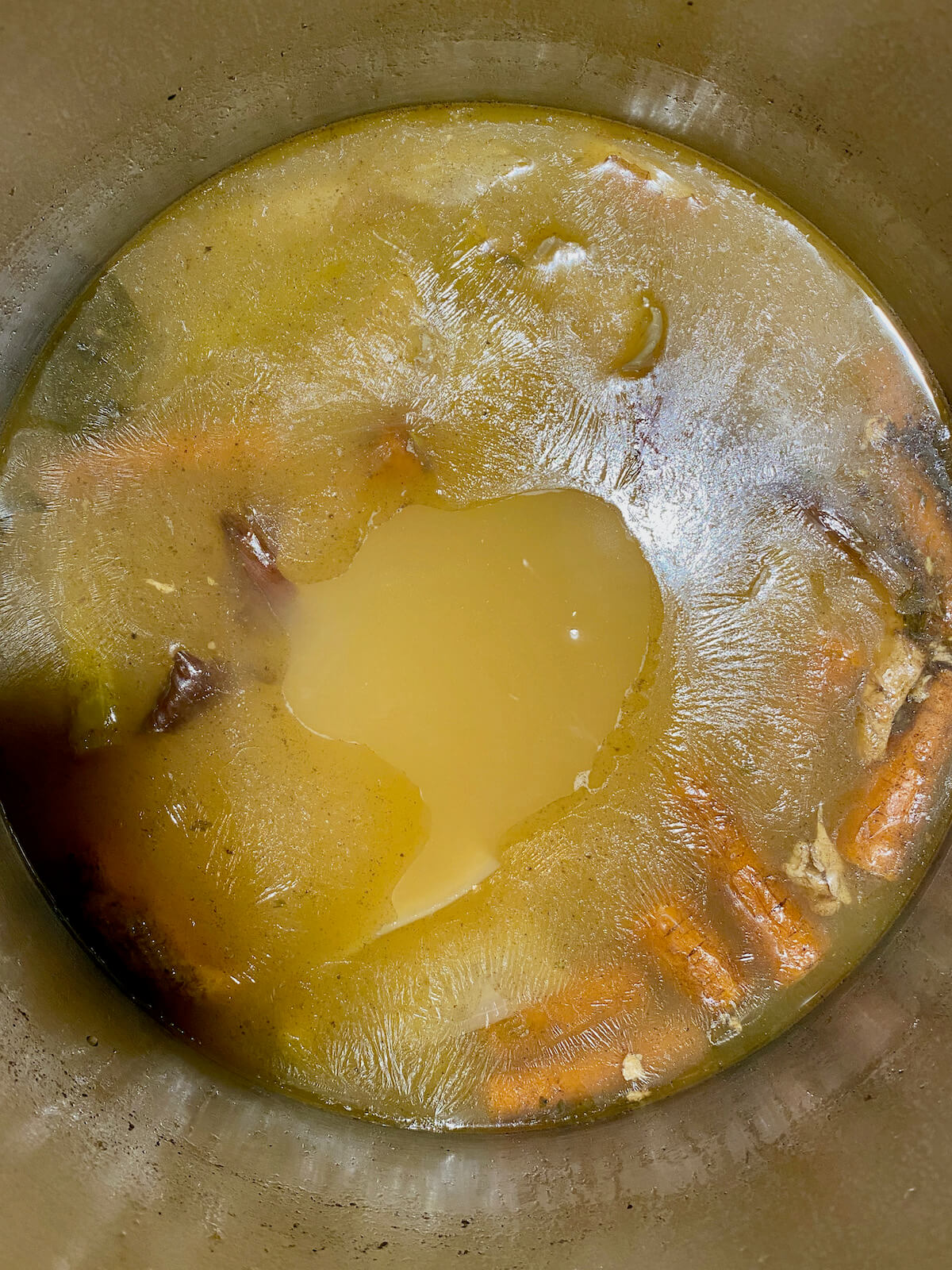
Step 3: Strain and store. Strain the chicken stock into a large bowl or container using a fine mesh sieve or cheesecloth. You can use the broth immediately or portion it out and store it in the refrigerator or freezer. If you want to reduce the fat, refrigerate the broth overnight, then use a slotted spoon to scoop the solid fat off the top.

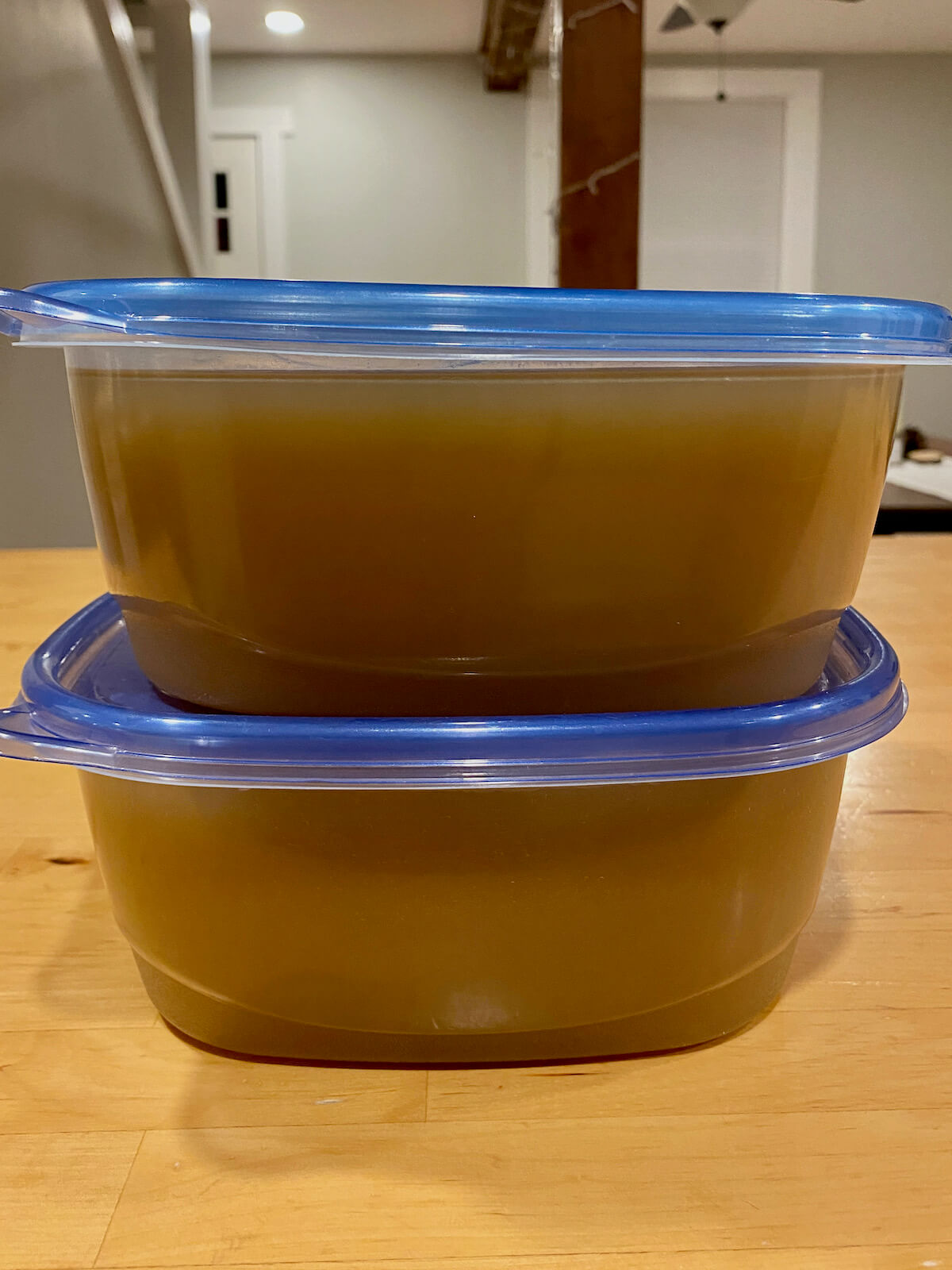
How to Strain Chicken Bone Broth
Chicken stock is easy to make, but straining it can be a little intimidating. Handling a large, heavy pot filled with hot liquid may seem overwhelming if this is your first time making chicken broth, but I promise it's easier than you think.
First, make sure you have a bowl or container large enough to hold at least 12 cups of chicken stock. If you don't, you'll have to strain in batches.
Then, determine how you plan to strain your stock. A fine mesh sieve placed directly inside the bowl works well. Alternatively, placing a colander lined with cheesecloth (or a clean tea towel) inside the bowl also works.
Now, all you have to do is pour the entire contents of the pot into your strainer. Then, lift the strainer up out of the bowl completely to ensure you strain all of the liquid out. And that's it! Easy, right?
If the pot is too heavy for you to lift, ask for assistance from a family member. If that's not an option, use a ladle to scoop the contents of the pot out and into the strainer instead.
Tips for Success
- Save scraps. I always have a "scrap bag" in my freezer. I save chicken bones, turkey bones, vegetable peels, vegetable ends, and garlic and onion skins. Then, when my bag fills up, I'll make a batch of stock on a day that is convenient for me.
- Plan ahead. While chicken stock is mostly hands-off and easy to make, it does require you to be home all day. Pick a rainy day or another day that you can be home for the 12 hours needed to make a batch of chicken bone broth.
- Make a double batch. If you have a large enough stock pot, I always recommend making a double batch and freezing it. If you're going to spend a day making chicken stock, you might as well make the most of it.
How to Use Chicken Bone Broth
Chicken bone broth is highly nutritious and versatile. Sipping it as a warm pick-me-up on a chilly winter day can help you feel your best.
But, chicken stock can also be used in a variety of recipes. Here are a few ideas:
- Soups and stews
- Cook rice, quinoa, farro, and other grains
- Deglaze a pan after searing meat or vegetables
- Braise meats
- Make chicken gravy
- Risotto
- Chicken pot pie filling
- Stir into mashed potatoes
- Homemade stuffing for Thanksgiving
- Sauté vegetables
- Poach chicken or fish
- Use it in meat marinade
Storage and Reheating
How to Store
- Refrigerator- Store chicken stock in an airtight container in the refrigerator for 3-4 days. After that, it's best to portion it into smaller containers and freeze it.
- Freezer- I love having homemade bone broth in my freezer. I recommend portioning your chicken stock into 2-4 cup portions and freezing it for up to 3 months for the best quality.
- Canning- If you own a pressure canner, this chicken bone broth recipe can be canned. Pressure canning chicken stock will make it shelf stable for up to one year.
How to Reheat
- Stovetop- Pour chicken stock into a saucepan and set it over medium heat. Heat until steaming and just about to simmer.
- Microwave- Place leftover chicken bone broth in a microwave-safe bowl or cup. Heat on HIGH in one-minute intervals, stirring between each, until piping hot.
Make Ahead
I love making large batches of chicken stock and stashing it away for future recipes. If I'm going to spend all day at home while it simmers away, I want it to be worth my while.
Chicken stock can be made ahead and stored in the freezer for 3-6 months. Alternatively, if you have a pressure canner at home, canning chicken bone broth will make it shelf stable for up to one year.
💡 Quick Tip: Freeze bone broth in ice cube trays for smaller portions that are great for adding to homemade sauces.
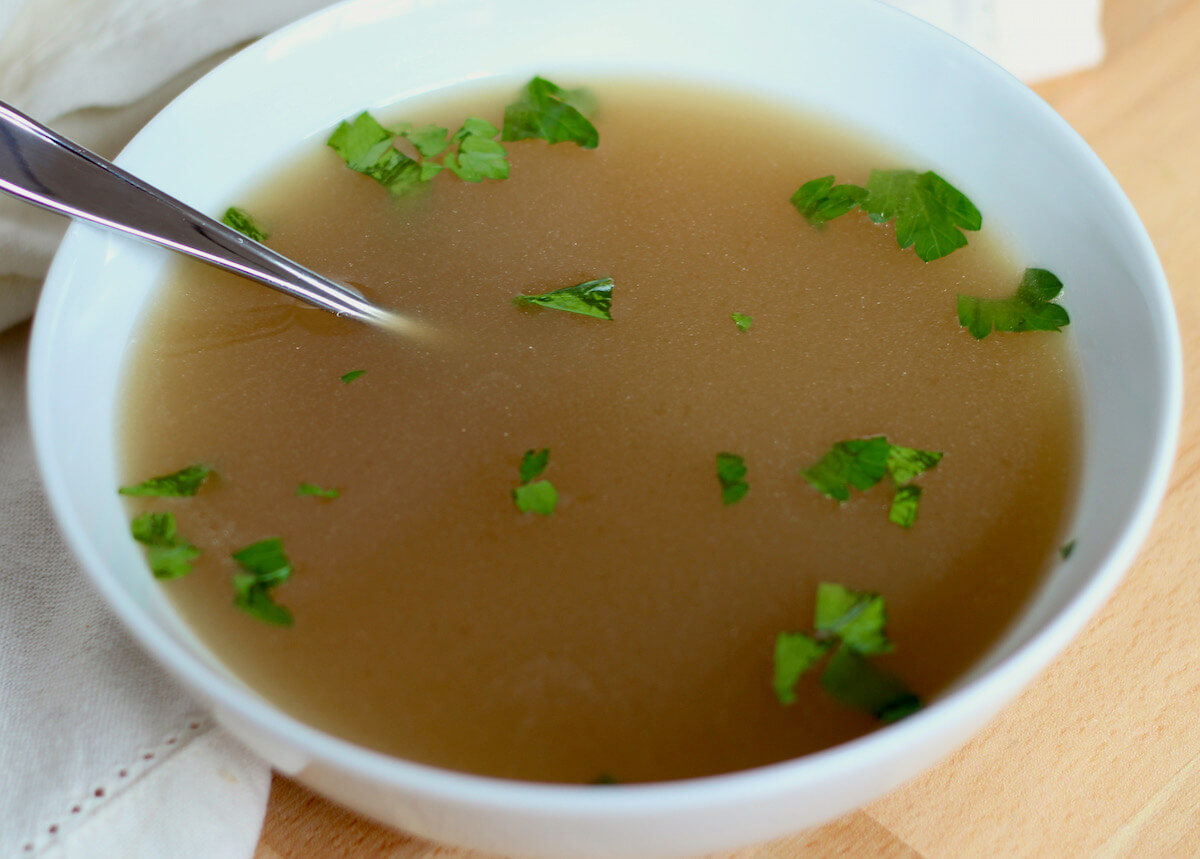
Frequently Asked Questions
Both chicken bone broth and beef bone broth are rich in vitamins, minerals, and amino acids. Which is better is a matter of taste preference, the types of recipes you make, and which bones are more readily available to you.
Bones with a lot of cartilage are best for making bone broth. Chicken feet, chicken wings, chicken backs, and whole chickens make great chicken bone broth.
For bone broth rich in collagen, you'll want to simmer the bones for at least 12 hours. Some recipes call for simmering the bones for as long as 48 hours, but I've personally never tried that.
While not a necessity, adding a splash of apple cider vinegar to your chicken stock may help draw more vitamins, minerals, and collagen out of the bones.
Since bone broth is simmered over a long period of time, leaving the lid on prevents too much evaporation from occurring. However, we do want some reduction of the liquid in our chicken stock. So, if your lid is particularly tight fitting, I recommend leaving it slightly askew on top of the stockpot.
Use 1-2 pounds of bones for every gallon of water.
Let's Connect!
Be sure to leave a comment below if you have any questions. You can also connect with me on Instagram, Facebook, Pinterest, or via email at [email protected].
📖 Recipe
How to Make Chicken Bone Broth
Ingredients
- 2 pounds chicken bones about 2 whole chickens
- 1 large onion quartered
- 3 large carrots cut into large chunks
- 3 ribs celery cut into large chunks
- 5 cloves garlic crushed
- 1 bay leaf
- 1 tablespoon apple cider vinegar
- 1 teaspoon kosher salt
- 20 cups water
Instructions
- Add the chicken bones, vegetables, bay leaf, vinegar, and kosher salt to a large stock pot. Pour in the water, making sure that everything is well-covered.
- Bring the water to a boil over medium-high heat, then reduce the heat to low so that the stock simmers gently. Skim off any foam that rises to the top as necessary. Cover and allow the stock to gently simmer for 12-14 hours.
- Strain the chicken stock into a large bowl or container using a fine mesh sieve or cheesecloth. You can use the broth immediately or portion it out and store it in the refrigerator or freezer. If you want to reduce the fat, refrigerate the broth overnight, then use a slotted spoon to scoop the solid fat off the top.
Notes
- Quick Tip: I always have a "scrap bag" in my freezer. I save chicken bones, turkey bones, vegetable peels, vegetable ends, and garlic and onion skins. Then, when my bag fills up, I'll make a batch of stock on a day that is convenient for me.
- Storage: Store chicken stock in an airtight container in the refrigerator for up to 4 days or in the freezer for up to 3 months (for best quality). I recommend freezing in 2-4 cup portions.

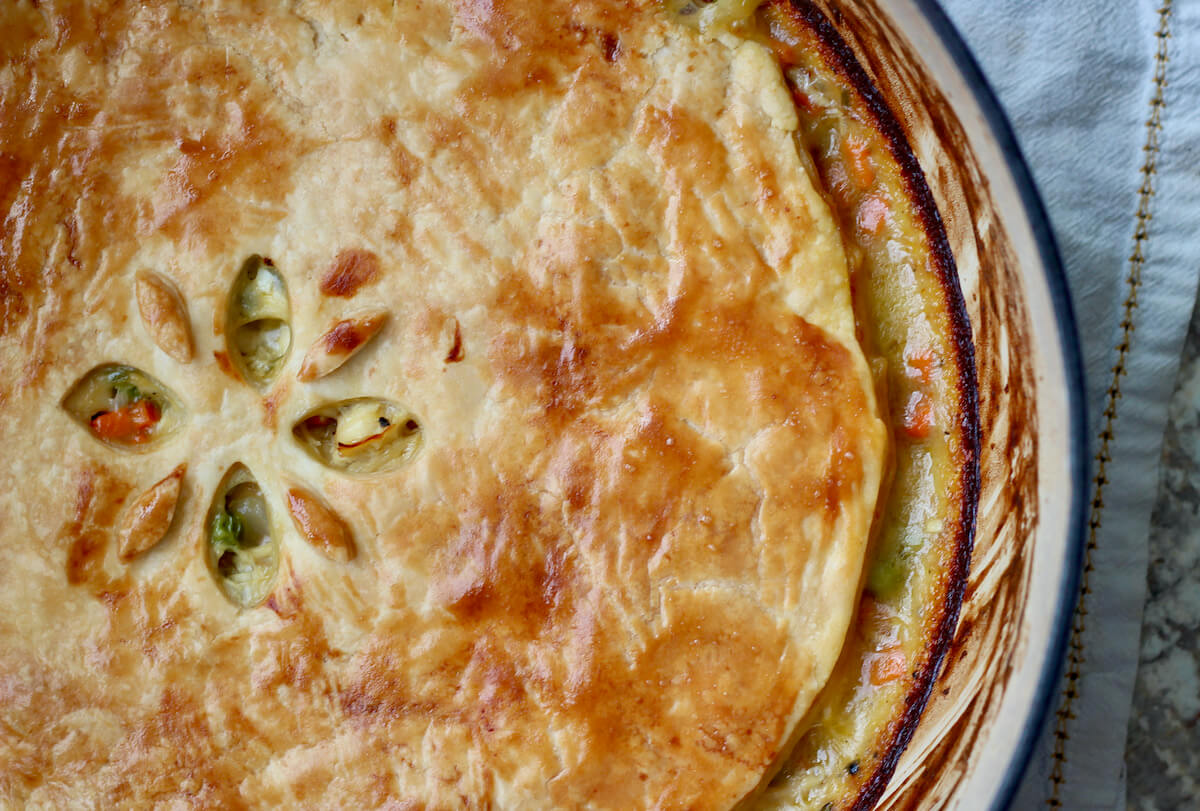


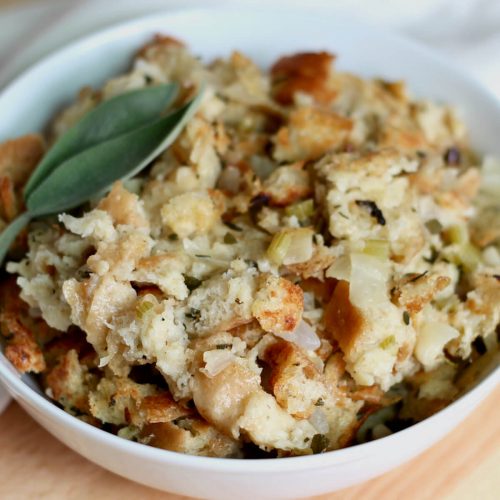






Comments
No Comments